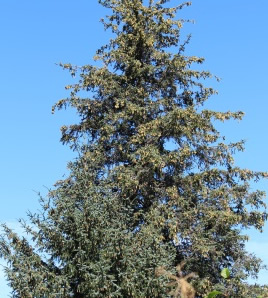Sitka Spruce

Botanical Name: Picea Stichensis
Common Name: Sitka Spruce
Other Names: napaq, naparpiaq (tree, real tree) The fact that the Alutiiq call spruce and tree by the same name, napaq, signifies the importance of Sitka spruce, as does its other name, naparpiaq, which translates as ‘real tree’.
Found in: a variety of soils and climatic conditions. Usually in wetlands, muskegs, on poorly drained clays and glacier tills in alpine valleys and slopes.
Physical Characteristics: This tall tree (100 to 200 feet) is found in coastal areas of South-central and South-eastern Alaska. Needles are ¾ to 1 1/8 inches long and slightly flattened with stomata only on the underside and slightly keeled at the ends. Branches tend to droop more than white spruce. The Large, long (2 to 3 ½ inches) cones have rippled bracts and fall off each spring (Pratt 1989). Sitka spruce is the most common tree on the southern Kenai Peninsula. As one might expect, the Alutiiq of the area have developed more uses for it than any other single species.
Nutritional Value: Beta carotene, starch, sugars, vitamin C
Parts of the plant used: Roots, pitch, bark, wood and decayed wood
When plant should be gathered: branch tips, boughs, roots and hardened resins (pitch) in spring, and bark and decayed wood can be gathered year round. Not only do the people employ every part of the Sitka spruce, but they use it in the primary areas of their livelihood, that is in their technology and as medicine and food.
Plant applications: Chew, Decoction, Powder, wood
Reported Benefits: armor/bow & arrows, bleeding/hemorrhages, broken bones, bug deterrent, canoes, colds/flu, containers, coughs/chest congestion, cuts/scrapes, earaches, fish traps, frost bite, general ill health, strong tool handles, heating homes/steam-baths, infections/inflammation, ladders, masks, pneumonia, rattles, shelter, snowshoe material, sore throat, toothaches, tuberculosis, tying, box making material, bug deterrent,
Preparation/Processing: Cuts/Scrapes, frostbite, general ill health: Sitka spruce roots were ground into a fine powder, cooked for 3 days until the mixture became a thick paste, and used when a person was “sick all over”. Warmed pitch was spread on frostbite and cuts (Birket-Smith 1953)
Colds/Flu, cough/chest congestion, sore throat, and tuberculosis: A decoction of Sitka spruce branch tips, gathered in spring was drunk for colds and tuberculosis (Wennekens 1983, 1985). A bark decoction (bark can be gathered year round) was drunk for coughs and colds. Spruce pitch was chewed for a sore throat or warmed and spread over a wound as a bandage (Wennekens 1985) And finally, Spruce cambium (boiled for five to fifteen minutes was drunk for sore throats, colds, and Pneumonia (Port Graham Students in Russell 1991) Raw cambium was also chewed for the same ailments or wrapped on cuts to stifle an infection. One person shared that chewing raw cambium cured a tooth infection (Russell 1991)
Earaches: To stop painful earaches, decayed spruce wood was warmed and poured into the ear. An informant shared that the heat, not the rotten spruce, was the most effect component of the treatment, the crumbled decayed wood was also applied to infected cuts and boils, without being heated. (Wennekens 1985)
Bleeding/hemorrhages, colds/flu, coughs/chest congestion, cuts/scrapes, sore throat, and tuberculosis: three types of spruce pitch are identified, yellow, white and pink. All three types of pitch were used for sore throats and colds (Port Graham Students in Russell 1991). Hard yellow pitch and hard white pitch were boiled and given to people with colds, coughs, and tuberculosis. For cuts, soft yellow pitch was warmed to staunch bleeding. In an emergency, any soft pitch was used without warming it. It was noted that the pitch should not be softened by chewing before use because wet pitch will not adhere to the skin (Russell 1991)
Broken bones: Spruce roots helped to secure wood used as a splint for broken bones (Russell 1991)
Heating homes/Steam baths, Furniture, masks, rattles, shelter, box making material, show shoe material, canoes, fish traps, strong tool handles, ladders, tying, weaving material, blocks of wood are broken down and used to heat homes and steam baths, and to make many various items listed.
